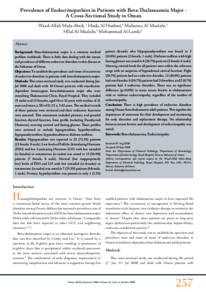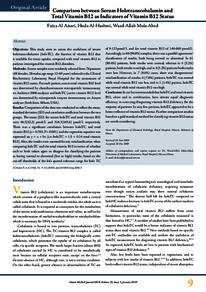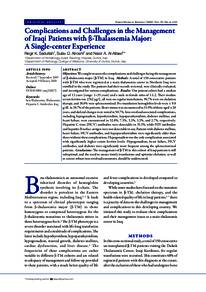Document
Prevalence of endocrinopathies in patients with beta-thalassaemia major : a cross-sectional study in Oman.
Contributors
Al-Hashmiyah, Huda., Author
Al-Muslahi, Muhanna., Author
Al-Muslahi, Hilal., Author
Al-Lamki, Mohammad., Author
Publisher
Oman Medical Specialty Board.
Gregorian
2008-10
Language
English
Subject
English abstract
Background: Beta-thalassaemia major is a common medical
problem worldwide. There is little data dealing with the nature
and prevalence of different endocrine disorders in this disease in
the Sultanate of Oman.
Objectives: To establish the prevalence and times of occurrence
of endocrine disorders in patients with beta-thalassaemia major.
Methods: This cross-sectional study was conducted during JanJul 2008 and dealt with 30 Omani patients with transfusiondependent homozygous beta-thalassaemia major who were
consulting Thalassaemia Clinic, Royal Hospital. They included
15 males and 15 females, aged 16 to 32 years with median of 21
years and mean ± SD of 21.23 ± 3.42 years. The medical records
of these patients were reviewed and their endocrine functions
were assessed. This assessment included pituitary and gonadal
function, thyroid function, bone profile (including Parathyroid
Hormone), morning cortisol and fasting glucose. These profiles
were reviewed to exclude hypogonadism, hypothyroidism,
hypoparathyroidism, hypoadrenalism or diabetes mellitus.
Results: Hypogonadism was reported in 22 (73.3%) patients
(13 female, 9 male). Low levels of Follicle-Stimulating Hormone
(FSH) and low Luteinizing Hormone (LH) with low estradiol
(in females) or testosterone (in males) was noted in 15 (50.0%)
patients (7 female, 8 male). Normal (but inappropriately
low) levels of FSH and LH with low estradiol (in females) or
testosterone (in males) was noted in 7 (23.3%) patients (6 female,
1 male). Primary hypothyroidism was present in only 1 (3.3%)
patient (female) who Hypoparathyroidism was found in 3
(10.0%) patients (2 female, 1 male). Diabetes mellitus with high
fasting glucose was noted in 8 (26.7%) patients (2 female, 6 male).
Morning cortisol levels for all patients were within the reference
range with no suspicion of hypoadrenal cortical function. Eight
(26.7%) patients had no endocrine disorder, 12 (40.0%) patients
had one disorder, 8 (26.7%) patients had 2 disorders, and 2 (6.7%)
patients had 3 endocrine disorders. There was no significant
difference (p>0.050) in mean serum ferritin in thalassaemics
with or without endocrinopathy, regardless of the number of
endocrinopathy.
Conclusion: There is high prevalence of endocrine disorders
among Omani beta-thalassaemic adult patients. This signifies the
importance of awareness for their development and monitoring
for early detection and replacement therapy. No relationship
between serum ferritin and development of endocrinopathy was
noted.
Member of
Resource URL
Citation
Mula-Abed, Waad-Allah, Al-Hashmiyah, Huda, Al-Muslahi, Muhanna, Al-Muslahi, & Al Lamki, Muhammad (2008).Prevalence of endocrinopathies in patients with beta-thalassaemia major : a cross-sectional study in Oman. Oman Medical Journal, 23 (4) 257-262.
Category
Journal articles



